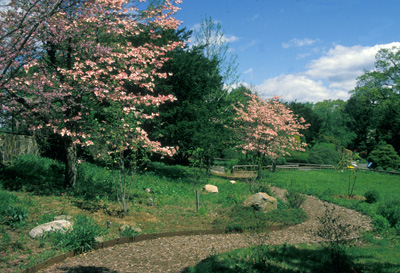Landscaping with Natives Is “In”
Posted in Learning Experiences on March 26 2009, by Plant Talk
 |
Brad Roeller is a research horticulturalist at the Cary Institute of Ecosystem Studies, formerly the Mary Flagler Cary Arboretum of The New York Botanical Garden. He has been an instructor at the Botanical Garden for over 25 years. |
 Over my three decades of gardening in the public arena, I’ve seen numerous landscaping trends come and go. However, landscaping with natives has always been popular, with current interest in this genre at an all-time high—and with good reason! A designer with a strong native plant background can meet virtually any design need by using native plants. Further, these days there seems to be something of a clarion call in the green industry to landscape with natives. I’m witnessing private, commercial, and even municipal planting specifications that are mandating, or at least strongly encouraging, using native plants in landscape designs.
Over my three decades of gardening in the public arena, I’ve seen numerous landscaping trends come and go. However, landscaping with natives has always been popular, with current interest in this genre at an all-time high—and with good reason! A designer with a strong native plant background can meet virtually any design need by using native plants. Further, these days there seems to be something of a clarion call in the green industry to landscape with natives. I’m witnessing private, commercial, and even municipal planting specifications that are mandating, or at least strongly encouraging, using native plants in landscape designs.
While this trend is sweeping the country, landscaping with natives is often done without much thought. Typically the designer is just substituting native counterparts of exotic plants using conventional design criteria. As with the increased interest in natives, another “in” industry phenomena is the concept of creating “sustainable” gardens and landscapes. My definition of a sustainable landscape is one where, once the plants are established (typically a one- to two-year process) the need for additional irrigation, fertilization, or pesticides should be nil. Sounds nice, but I have seen very few examples of sustainable landscapes.
Many “sustainable” landscape designers are using the “natural” model, going “wild” by using native plants in a more naturalistic design. While these intentions are laudable, unless one thoroughly analyzes the growing characteristics of the property and makes wise plant selections based on their investigations, their plantings are destined to need continued sustenance. Even if the necessary site investigations are made and plants are selected based upon growing constraints, unless accepted planting and post-planting care guidelines are used, even the best natives for your site will perform poorly.
One popular application associated with landscaping with natives involves restoration projects in woodlands, meadows, wetlands or other riparian areas where the goal is to introduce indigenous native species back into their representative habitats. This approach is also finding some popularity in residential and even commercial landscapes. While it is typically used for large areas that have varying degrees of functioning native plant communities present, it does have a place in “small” landscapes. The time has come for ecologically designed landscape, and there is no reason that even the smallest of landscapes can’t duplicate a particular and appropriate habitat and landscape with plants obligate to that ecological niche.
This approach is not for the faint of heart and does require something of a learning curve. A working knowledge of the natives of your region coupled with an understanding of some important ecological principles is essential in establishing sustainable native plant communities.
Brad Roeller will be teaching three classes March 28 during Native Plants Saturday, an all-day Continuing Education program in the Watson Education Building at The New York Botanical Garden.


Landscaping with native plants is something we should all consider. The number of plants that have been “imported” into the Arizona desert is alarming and sad (especially for allergy sufferers!). Thanks for a great post.